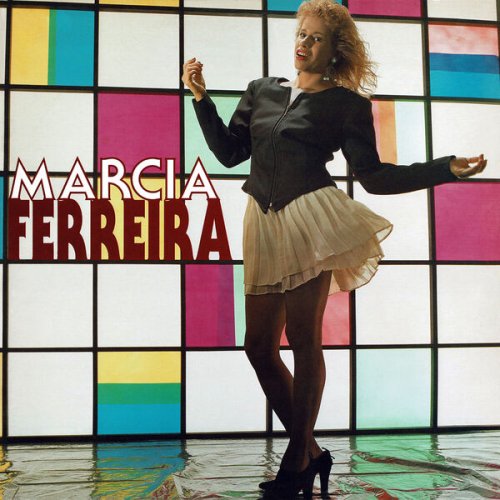Maria Callas, Tullio Serafin - Puccini: Manon Lescaut (1985) CD-Rip
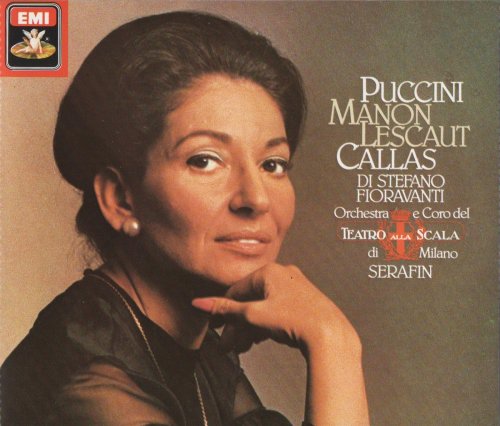
Artist: Maria Callas, Tullio Serafin
Title: Puccini: Manon Lescaut
Year Of Release: 1985
Label: EMI
Genre: Classical
Quality: FLAC (image+.cue,log,scans)
Total Time: 02:00:34
Total Size: 613 Mb
WebSite: Album Preview
Tracklist: Title: Puccini: Manon Lescaut
Year Of Release: 1985
Label: EMI
Genre: Classical
Quality: FLAC (image+.cue,log,scans)
Total Time: 02:00:34
Total Size: 613 Mb
WebSite: Album Preview
Giacomo Puccini (1858-1924)
Manon Lescaut - opera in 4 acts
CD 1:
01. Atto Primo - Ave,sera gentile [0:04:30.15]
02. Atto Primo - Non rispondi Perch [0:01:15.72]
03. Atto Primo - Tra voi,belle,brune e bionde [0:01:17.43]
04. Atto Primo - Ma bravo! [0:01:52.17]
05. Atto Primo - Discendono, vediam [0:02:10.13]
06. Atto Primo - Cortese damigella [0:04:15.20]
07. Atto Primo - Donna non vidi mai [0:02:36.02]
08. Atto Primo - La tua ventura ci rassicura [0:06:11.65]
09. Atto Primo - La tua Proserpina [0:01:50.20]
10. Atto Primo - Vedete, io son fedele [0:04:26.28]
11. Atto primo - Non c' pi vino [0:02:59.35]
12. Atto Primo - Cavalli pronti avete [0:02:58.37]
13. Atto Secondo - Dispettosetto, questo riccio [0:04:56.45]
14. Atto Secondo - In quelle trine morbide [0:02:15.25]
15. Atto Secondo - Poich tu vuoi saper [0:02:56.10]
16. Atto Secondo - Che ceffi son costor [0:02:14.18]
17. Atto Secondo - Paga costor! [0:01:18.50]
18. Atto Secondo - Vi prego, signorina [0:08:37.32]
CD 2:
01. Atto Secondo - Oh, sarò la più bella.. [0:08:19.62]
02. Atto Secondo - Ah!..Affè, madamigella [0:01:55.40]
03. Atto Secondo - Ah!Ah!Liberi!.. [0:03:51.40]
04. Atto Secondo - Lescaut?!..Tu,qui?! [0:03:29.60]
05. Atto Secondo - Intermezzo [0:05:17.08]
06. Atto Terzo - Ansia,eterna,crudel [0:04:30.00]
07. Atto Terzo - ..e Kate rispose al Re.. [0:01:27.00]
08. Atto Terzo - Manon, disperato è il mio prego! [0:01:30.27]
09. Atto Terzo - All'armi!All'armi! [0:01:49.23]
10. Atto Terzo - Rosetta!...Che aria! [0:03:59.00]
11. Atto Terzo - Presto in fila!..No!Pazzo son [0:03:39.67]
12. Atto Quarto - Tutta su me ti posa [0:03:07.28]
13. Atto Quarto - Manon..senti,amor mio [0:02:09.02]
14. Atto Quarto - Sei tu che piangi? [0:04:30.70]
15. Atto Quarto - Sola,perduta,abbandonata.. [0:05:00.45]
16. Atto Quarto - Fra le tue braccia amore.. [0:07:01.00]
Performers:
Maria Callas
Giulio Fioravanti
Giuseppe di Stefano
Franco Calabrese
Dino Formichini
Carlo Forti
Vito Tatone
Fiorenza Cossotto
Giuseppe Morresi
Franco Ricciardi
Franco Ventriglia
Coro del Teatro alla Scala
Orchestra del Teatro alla Scala
Tullio Serafin - conductor
Manon Lescaut, the earliest of Puccini’s operas to enjoy continuing international success, has attracted some very starry casts on record. There are plenty of recordings vying for recommendation alongside this vintage 1957 set, reissued by EMI with the libretto and synopsis now on a Bonus Disc. Rival sets are good or very good.
Maria Callas’s voice sounds rather harsh here with the result being less satisfying than some of her other Puccini heroines - notably her Madama Butterfly with Karajan (1955) and her astonishing Mimi in La Read more (1956) - the latter recorded just a year before this set and one of her finest records. As Manon, Licia Albanese is full of personality but the voice sounds old in 1954 (RCA) while Kiri Te Kanawa is not very dramatic for Chailly (Decca). Montserrat Caballé’s recording fails to catch fire although there are some lovely effects. She is not helped by an off-form Bruno Bartoletti conducting and Placido Domingo who is not nearly as interesting as he is live on DVD or in the later Sinopoli set.
On more recent recordings, Mirella Freni is pretty much ideal with the earlier set sounding very beautiful with the singers quite far away from the microphones. The Levine performance, although catching Freni in her fifties, is probably the most satisfying of all alongside an excellent cast. The Callas performance is more dramatic and interesting than most of the others but her voice is far less even - especially compared to Montserrat Caballé or Renata Tebaldi for Decca.
Serafin’s conducting is the best on records along with that of Jonel Perlea. Some more recent recordings are well conducted such as the Sinopoli set but with Serafin the speeds always sound right and are less contentious than those of Sinopoli on DG. The Levine set for Decca is less flexible but exciting in its own way. The conducting of Bruno Bartoletti with Montserrat Caballé and Domingo is rather dull.
What remains mesmerizing is the gusto of this performance with Callas's creativity and intelligence evident throughout. Sample her way with words in “Vedete? io son fedele” Another example is the duet with Des Grieux “Oh, sarò la più bella! ... Tu, tu amore? Tu?” Callas's performance is rhythmically tight and the emotions of this fickle character are expressed dramatically in a way that is often missing from the more vocally even performances of Caballé, Freni or Te Kanawa. The coloratura sections of the score hold no fear for Callas where other singers have been caught out.
What a fascinating character she creates. She can invest phrases with pathos and tragic grandeur. In “Sola, perduta, abbandonata” memorable accents stay in the mind for days afterwards. The delicate beginning of “In quelle trine morbide”, which is so risky, asks for great concentration from the singer. The tension rises as the voice has to swell with the orchestra to an astonishing climax.
The voice of Giuseppe Di Stefano is at times rather thin but his performance is satisfyingly dramatic - different but equal to Jussi Björling and more youthful than Placido Domingo or Luciano Pavarotti. For all the similarities critics cite between Carreras and Di Stefano the older singer really wipes the floor with Carreras in terms of phrasing and vocal quality - when things get dramatic Carreras barks alarmingly on the Chailly set. This is probably the best of Di Stefano's later recordings (1957 onwards) along with the Lucia di Lammermoor with Renata Scotto from 1959.
Di Stefano is an exciting Des Grieux using all his skill to navigate what is by nature a lyrical voice through a very demanding role. The elegance of his phrasing - sample “Ah manon mi tradice ...” - means he does not bark or grunt like so many Des Grieuxs when the tension escalates (“Oh, sarò la più bella! ... Tu, tu amore? Tu?” or “No! pazzo son!”). He is an unusually alert and youthful protagonist. This pays dividends at the start of the opera where “Tra voi, belle, brune e blonde” and “Donna non vidi mai” enjoy a mixture of light and shade. There are times such as in “Ah Manon mi tradice” when one might like a richer and darker voice - perhaps more like Carlo Bergonzi or Placido Domingo who are both amazing in some live records - however Di Stefano achieved much through understatement. He is lyrical where other tenors can sound like sergeant-majors barking orders and, as with his Canio ( Pagliacci), you find that his way with words and rhythm generates its own excitement. The Act 3 outburst “Ah Non V’avvicinate!” and Act 4 “Manon senti amor mio” are perhaps the most successful of all even though he has to achieve by art what others more readily have by nature.
Jussi Björling is excellent throughout with Perlea although his performance of “Tra voi belle” lacks humour. Mario Del Monaco for Decca uses his huge ringing voice - by nature ideal for this role - in a loud and inflexible way. Live recordings by Del Monaco, Bergonzi and Richard Tucker are all richer-voiced than Di Stefano with certain episodes sounding far more exciting than any studio recording. That said, all too often the results are overblown and hysterical with sobs, wails and shouting disrupting the musical line. One can imagine Carlo Bergonzi’s performance being astonishing in the opera house but on record and with repeated listening the effects can sound hammy.
Baritone Giulio Fioravanti had a lighter and more lyrical voice than some other Lescauts on record but he is well matched with Callas - for example in “Poichè Tu Vuoi Saper”. His voice is flexible and smooth as well as being characterful next to Di Stefano in Act 3. If the performance lacks the warm sound of Renato Bruson for Sinopoli or Dwayne Croft for Levine the results still sound excellent amid the team of fine artists present in this recording - a well matched group. The vivid personality of Robert Merrill stands out as the great strength of the Perlea set and he has not been equalled on record. His partnership with Jussi Björling at “Ansia, Eterna, Crudel” is superbly characterized.
The sound is dry and somewhat harsh as re-mastered here - there are times the voices cannot 'bloom' properly. The best recorded sound belongs to the closely-miked Pavarotti/Freni/Levine recording or the more distant sounding Sinopoli set (Chailly comes somewhere in-between with Carreras and Te Kanawa (also digital stereo). This recording could do with an overhaul - re-mastered from the original tapes. With the EQ boosted and some reverberation added it would probably come up well with the voices forward and immediate; the technology has improved since this attempt in 1997. It is only a shame that this was not made in stereo like Callas's Il Barbiere di Siviglia or like Di Stefano's contemporary recordings with Decca.
This is a dramatic and engaging performance of an exciting opera. A few ‘raw’ patches notwithstanding this is a classic set. -- David Bennett
Maria Callas’s voice sounds rather harsh here with the result being less satisfying than some of her other Puccini heroines - notably her Madama Butterfly with Karajan (1955) and her astonishing Mimi in La Read more (1956) - the latter recorded just a year before this set and one of her finest records. As Manon, Licia Albanese is full of personality but the voice sounds old in 1954 (RCA) while Kiri Te Kanawa is not very dramatic for Chailly (Decca). Montserrat Caballé’s recording fails to catch fire although there are some lovely effects. She is not helped by an off-form Bruno Bartoletti conducting and Placido Domingo who is not nearly as interesting as he is live on DVD or in the later Sinopoli set.
On more recent recordings, Mirella Freni is pretty much ideal with the earlier set sounding very beautiful with the singers quite far away from the microphones. The Levine performance, although catching Freni in her fifties, is probably the most satisfying of all alongside an excellent cast. The Callas performance is more dramatic and interesting than most of the others but her voice is far less even - especially compared to Montserrat Caballé or Renata Tebaldi for Decca.
Serafin’s conducting is the best on records along with that of Jonel Perlea. Some more recent recordings are well conducted such as the Sinopoli set but with Serafin the speeds always sound right and are less contentious than those of Sinopoli on DG. The Levine set for Decca is less flexible but exciting in its own way. The conducting of Bruno Bartoletti with Montserrat Caballé and Domingo is rather dull.
What remains mesmerizing is the gusto of this performance with Callas's creativity and intelligence evident throughout. Sample her way with words in “Vedete? io son fedele” Another example is the duet with Des Grieux “Oh, sarò la più bella! ... Tu, tu amore? Tu?” Callas's performance is rhythmically tight and the emotions of this fickle character are expressed dramatically in a way that is often missing from the more vocally even performances of Caballé, Freni or Te Kanawa. The coloratura sections of the score hold no fear for Callas where other singers have been caught out.
What a fascinating character she creates. She can invest phrases with pathos and tragic grandeur. In “Sola, perduta, abbandonata” memorable accents stay in the mind for days afterwards. The delicate beginning of “In quelle trine morbide”, which is so risky, asks for great concentration from the singer. The tension rises as the voice has to swell with the orchestra to an astonishing climax.
The voice of Giuseppe Di Stefano is at times rather thin but his performance is satisfyingly dramatic - different but equal to Jussi Björling and more youthful than Placido Domingo or Luciano Pavarotti. For all the similarities critics cite between Carreras and Di Stefano the older singer really wipes the floor with Carreras in terms of phrasing and vocal quality - when things get dramatic Carreras barks alarmingly on the Chailly set. This is probably the best of Di Stefano's later recordings (1957 onwards) along with the Lucia di Lammermoor with Renata Scotto from 1959.
Di Stefano is an exciting Des Grieux using all his skill to navigate what is by nature a lyrical voice through a very demanding role. The elegance of his phrasing - sample “Ah manon mi tradice ...” - means he does not bark or grunt like so many Des Grieuxs when the tension escalates (“Oh, sarò la più bella! ... Tu, tu amore? Tu?” or “No! pazzo son!”). He is an unusually alert and youthful protagonist. This pays dividends at the start of the opera where “Tra voi, belle, brune e blonde” and “Donna non vidi mai” enjoy a mixture of light and shade. There are times such as in “Ah Manon mi tradice” when one might like a richer and darker voice - perhaps more like Carlo Bergonzi or Placido Domingo who are both amazing in some live records - however Di Stefano achieved much through understatement. He is lyrical where other tenors can sound like sergeant-majors barking orders and, as with his Canio ( Pagliacci), you find that his way with words and rhythm generates its own excitement. The Act 3 outburst “Ah Non V’avvicinate!” and Act 4 “Manon senti amor mio” are perhaps the most successful of all even though he has to achieve by art what others more readily have by nature.
Jussi Björling is excellent throughout with Perlea although his performance of “Tra voi belle” lacks humour. Mario Del Monaco for Decca uses his huge ringing voice - by nature ideal for this role - in a loud and inflexible way. Live recordings by Del Monaco, Bergonzi and Richard Tucker are all richer-voiced than Di Stefano with certain episodes sounding far more exciting than any studio recording. That said, all too often the results are overblown and hysterical with sobs, wails and shouting disrupting the musical line. One can imagine Carlo Bergonzi’s performance being astonishing in the opera house but on record and with repeated listening the effects can sound hammy.
Baritone Giulio Fioravanti had a lighter and more lyrical voice than some other Lescauts on record but he is well matched with Callas - for example in “Poichè Tu Vuoi Saper”. His voice is flexible and smooth as well as being characterful next to Di Stefano in Act 3. If the performance lacks the warm sound of Renato Bruson for Sinopoli or Dwayne Croft for Levine the results still sound excellent amid the team of fine artists present in this recording - a well matched group. The vivid personality of Robert Merrill stands out as the great strength of the Perlea set and he has not been equalled on record. His partnership with Jussi Björling at “Ansia, Eterna, Crudel” is superbly characterized.
The sound is dry and somewhat harsh as re-mastered here - there are times the voices cannot 'bloom' properly. The best recorded sound belongs to the closely-miked Pavarotti/Freni/Levine recording or the more distant sounding Sinopoli set (Chailly comes somewhere in-between with Carreras and Te Kanawa (also digital stereo). This recording could do with an overhaul - re-mastered from the original tapes. With the EQ boosted and some reverberation added it would probably come up well with the voices forward and immediate; the technology has improved since this attempt in 1997. It is only a shame that this was not made in stereo like Callas's Il Barbiere di Siviglia or like Di Stefano's contemporary recordings with Decca.
This is a dramatic and engaging performance of an exciting opera. A few ‘raw’ patches notwithstanding this is a classic set. -- David Bennett
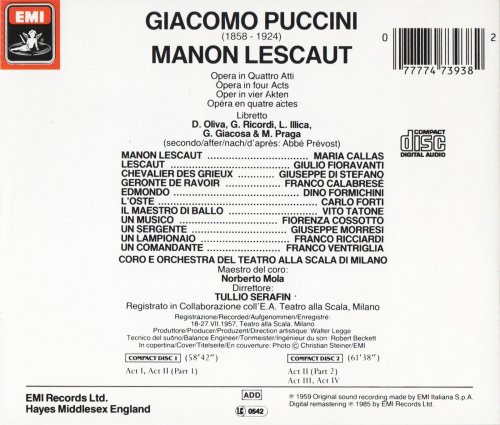
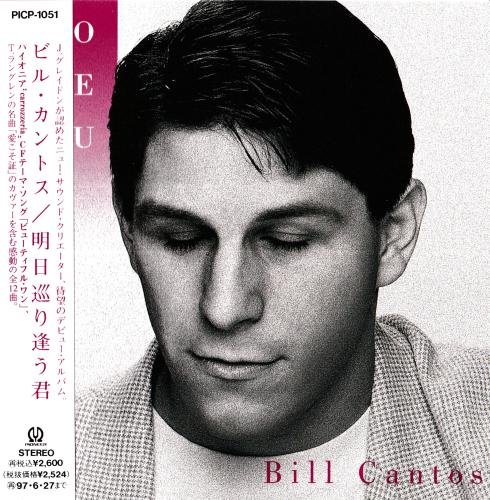
![Tom Cohen - Embraceable Brazil (2025) [Hi-Res] Tom Cohen - Embraceable Brazil (2025) [Hi-Res]](https://img.israbox.com/img/2025-12/18/vgt0kbsml69jbixcu67jkruae.jpg)

![Ready Player 3 - Ready Player 3 (2025) [Hi-Res] Ready Player 3 - Ready Player 3 (2025) [Hi-Res]](https://www.dibpic.com/uploads/posts/2025-12/1766128773_cover.jpg)
![Bryan Ferry - Bitter-Sweet (2018) [Hi-Res] Bryan Ferry - Bitter-Sweet (2018) [Hi-Res]](https://www.dibpic.com/uploads/posts/2018-11/1543491501_folder.jpg)
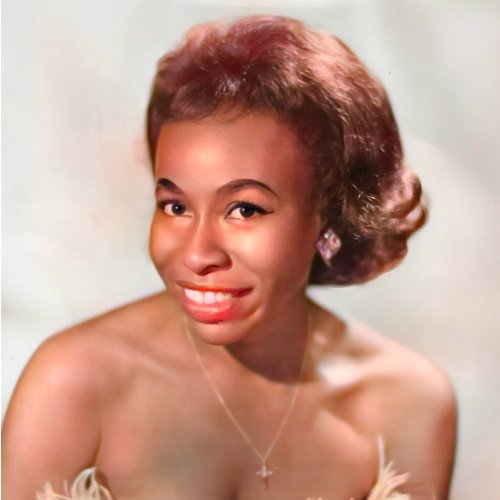
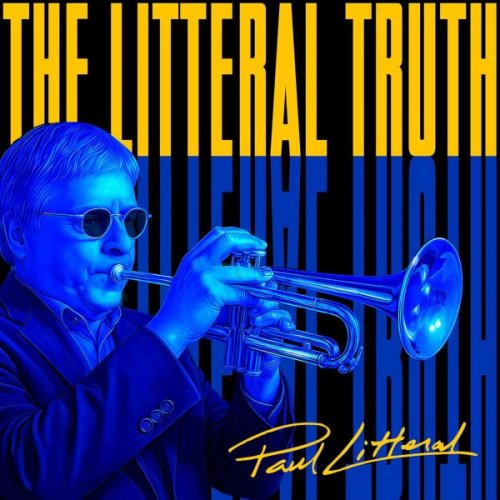
![Clifton Chenier - Bon Ton Roulet! (1967) [Hi-Res] Clifton Chenier - Bon Ton Roulet! (1967) [Hi-Res]](https://img.israbox.com/img/2025-12/20/a5svymspyands9f5esq020o3f.jpg)
